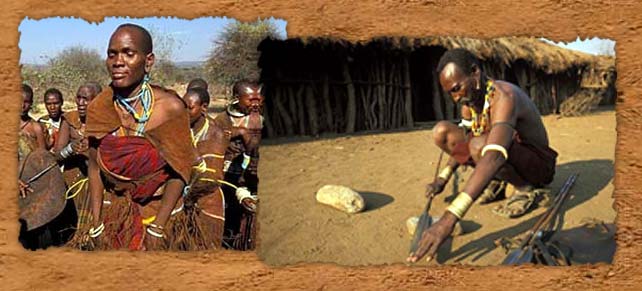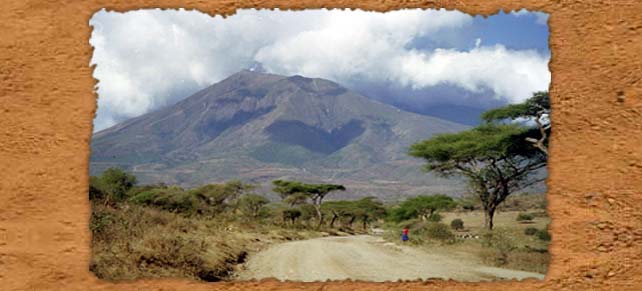|
|
The people of Babati/Hanang offer:
- A special Barbaig cultural insight hike
- An exclusive Mount Hanang climb
- Cycling expeditions through remote areas
- A fishing adventure with local canoes on Lake Babati while viewing hippos
- A chance to participate in local brick and pottery making and beer brewing
- A visit to development projects like cattle and goat dairy farming, piped water projects, bio-gas energy...
Babati district is located along the Arusha-Dodoma road in the Rift Valley, south of Lake Manyara Park and west from Tarangire. The town boasts Lake Babati where floating hippos can be seen and which is rich in fish, both tilapia and Nile perch. Here commercial and farming tribes co-exist with conservative cattle herding tribes to provide a distinguished cultural contrast. In Hanang District close by the beautiful Mount Hanang (3418m), live the Barbaig people whose traditional culture is still unchanged and unspoilt. The women wear traditional goatskin dresses and the men walk around with spears. Visitors can mix freely with the Barbaig, commonly known as the Mang’ati living in the Mang’ati plains. If you are interested in bird watching, 400 bird species will welcome you on your walks in the area.
|
|
 |
Facilities: Full board accommodations in selected local hotels and guesthouses in Babati and Katesh. Selected family homes / huts in the villages with basic standards and without running water. Temporary self catering campsites can be organised. In the villages women provide food. Lunch boxes can be ordered from Joas Kahembe.
Recommended equipment: Good walking shoes, sleeping bag (mattress), water bottle, filter or micro-pure tablets, anti-malaria pills and torch.
Development Projects: In Managhat the villagers decided to invest the Village Development Fee for the rehabilitation of the primary school.
Guides: English speaking guides who know the area will help you around. A Barbaig born guide will tell you about Barbaig culture. Guides wear an identity card of the Cultural Tourism Programme.
|
 |
How to get there: All the tours are organized by the coordinator Mr.Kahembe at Babati 172 km from Arusha. There are regular bus services Arusha to Babati starting from 7.30 a.m. Within 3 hours you will reach Babati centre. From Karatu it is a 5 hours drive to Babati. Ask for Kahembe’s Guest House, a 5 minutes walk from the main bus stand. Transfers can be organized by the coordinator=s office at special tariff.
Katesh is a one and a half hours drive from Babati or four and a half hours drive from Karatu. A distance which can be covered by public transport or by private vehicle.
Half day tour: You visit Managhat village, original home of the Gorowa tribe but now also a home for migrants. You will see dairy farming activities, farming with ox plow, bio gas system, local Gorowa huts and a Killer Beekeeping Project at the bottom of Mount Kwaraa (2415m)
One day tour: You walk to Managhat village (see above) and climb Bambaay Hill from where you see the beautiful Rift Valley landscape with Lake Babati and Lake Manyara. The Rift Valley Escarpment in the background and the Masaai Steppe at the east. Later you visit a respected Gorowa tribesmans, Mzee Kwaraa, at his home. He will tell you about Gorowa culture, marriage, rain prayers, burial, religious and circumcision rituals. Optionally one can row, fish and view hippos on Lake Babati, using local canoes.
|
|
Three Days Special Barbaig Tour
Day 1: This tour begins with a 70 km bus ride from Babati to Katesh. Lunch in a local hotel. From here you start a 16 km bush walk towards the Mangati plains. In Dirma, a Barbaig nomad village, you will be warmly welcomed at Mzee Gavachu’s boma. In no time you will see Barbaig women and men coming to see their new guests. Our Barbaig guide will help to translate where only Barbaig language is spoken. Seated on three legged stools you have dinner prepared by the women. In the huts a bed with a skin only is waiting for you.
Day 2: A relaxed day where the visitor can mix freely with people and gain the cultural insights from men and women, taking pictures together and knowing more about procedures of marriage, burial of elderly men, religious rituals, local taboos etc. Have a look at how they make the goatskin gowns and the ornaments, how they prepare the famous honey brew called Gisuda. One can try to herd cattle or fetch water the Barbaig way. The only school and dispensary can be visited where you can talk with teachers and nurses.
Day 3: Walk back to Katesh, where you have lunch, further bus trip to Babati or Arusha.
|
|
Mount Hanang (3418m) Trekking: From Katesh, the fourth highest mountain of Tanzania, can be climbed in one day. An early start is necessary with guides and porters through farmland, forest, scrub and grasslands. Finally, after 5 - 6 hours walking, you will reach the summit. Another 3 - 4 hours is needed for the descent. But it is advisable to climb from Gendabi at the foot of the mountain, a 3 hours walk from Katesh. Teachers from the Secondary school will provide accommodation and food. After spending the night in the village you climb and have more time to enjoy the scenery. Summiteers will receive a certificate.
God’s Bridge Walk: Drive from Babati to Bacho village at the foot of the Rift Wall where you visit local fish ponds. Along local paths climb the escarpment and visit God=s Bridge with a fantastic view. Descend and walk to the main road where you drive back to Babati
Combined tours: All tours can be combined. A cycling expedition can be organized on request. |
|
| |
 |
|
|
|
|




